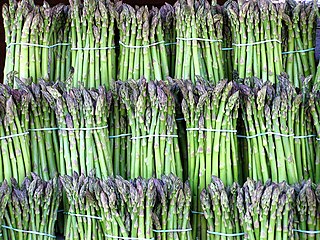
Asparagus, or garden asparagus, folk name sparrow grass, scientific name Asparagus officinalis, is a perennial flowering plant species in the genus Asparagus. Its young shoots are used as a spring vegetable.

The Savage Islands or Selvagens Islands are a small Portuguese archipelago in the North Atlantic Ocean, 280 kilometres (175 mi) south of Madeira, and 165 kilometres (105 mi) north of the Canary Islands. The archipelago includes two major islands, Selvagem Grande and Selvagem Pequena, each surrounded by a cluster of islets and reefs, with the total area of 2.73 km2. The archipelago is administered as part of the Portuguese municipality of Funchal, belongs to the Madeiran civil parish of Sé, and is the southernmost point of Portugal.

Macaronesia is a collection of four volcanic archipelagos in the North Atlantic Ocean, off the coasts of the continents of Europe and Africa. Each archipelago is made up of a number of Atlantic oceanic islands, which are formed by seamounts on the ocean floor and have peaks above the ocean's surface. Some of the Macaronesian islands belong to Portugal, some belong to Spain, and the rest belong to Cape Verde. Politically, the islands belonging to Portugal and Spain are part of the European Union. Geologically, Macaronesia is part of the African tectonic plate. Some of its islands - the Azores - are situated along the edge of that plate at the point where it abuts the Eurasian and North American plates.
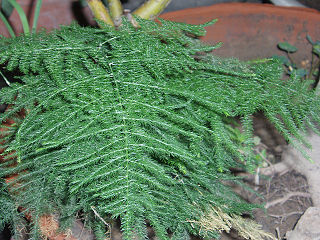
Asparagus is a genus of flowering plants in the family Asparagaceae, subfamily Asparagoideae. It comprises up to 300 species. Most are evergreen long-lived perennial plants growing from the understory as lianas, bushes or climbing plants. The best-known species is the edible Asparagus officinalis, commonly referred to as just asparagus. Some other members of the genus, such as Asparagus densiflorus, are grown as ornamental plants.

Limonium is a genus of 120 flowering plant species. Members are also known as sea-lavender, statice, caspia or marsh-rosemary. Despite their common names, species are not related to the lavenders or to rosemary. They are instead in Plumbaginaceae, the plumbago or leadwort family. The generic name is from the Latin līmōnion, used by Pliny for a wild plant and is ultimately derived from the Ancient Greek leimon.

Lolium is a genus of tufted grasses in the bluegrass subfamily of the grass family. It is often called ryegrass, but this term is sometimes used to refer to grasses in other genera.
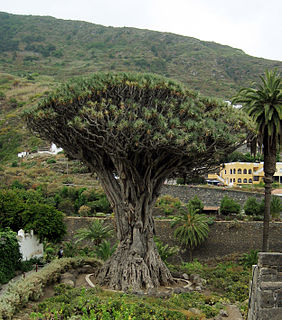
Dracaena draco, the Canary Islands dragon tree or drago, is a subtropical tree in the genus Dracaena, native to the Canary Islands, Cape Verde, Madeira, western Morocco, and is thought to be introduced in the Azores. It is the natural symbol of the island of Tenerife, together with the blue chaffinch. Its closest living relative is the dragon's blood tree of Socotra, Dracaena cinnabari.
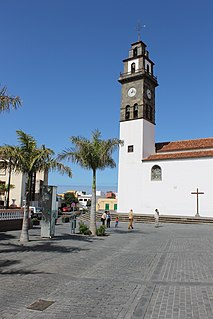
Buenavista del Norte is a municipality and town on the north west coast of Tenerife, located on route TF42, about 75 km west of the capital Santa Cruz de Tenerife, 65 km from Tenerife North Airport and 66 km from Tenerife South Airport.

Phoenix canariensis is a species of flowering plant in the palm family Arecaceae, native to the Canary Islands. It is a relative of Phoenix dactylifera, the true date palm. It is the natural symbol of the Canary Islands, together with the canary Serinus canaria. Mature P. canariensis are often used in ornamental landscaping and are collected and transplanted to their new planting location. A Canary Island date palm with 10 m (30 ft) of trunk is approximately 60 years of age.

Asparagus setaceus, commonly known as common asparagus fern, asparagus grass, lace fern, climbing asparagus, or ferny asparagus, is a climbing plant in the genus Asparagus. Despite its common name, the plant is not a true fern, but has leaves that resemble one.
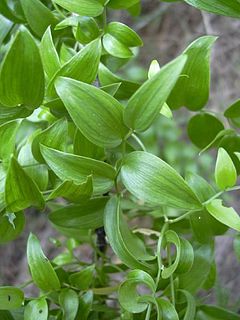
Asparagus asparagoides, commonly known as bridal creeper, bridal-veil creeper, gnarboola, smilax or smilax asparagus, is a herbaceous climbing plant of the family Asparagaceae native to eastern and southern Africa. Sometimes grown as an ornamental plant, it has become a serious environmental weed in Australia and New Zealand.
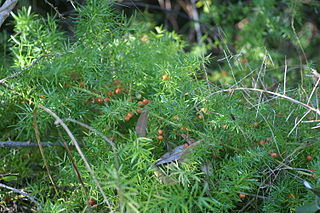
Asparagus aethiopicus, Sprenger's asparagus, is a plant native to the Cape Provinces and the Northern Provinces of South Africa. Often used as an ornamental plant, it is considered an invasive weed in many locations. Asparagus fern, asparagus grass and foxtail fern are common names; however, it is unrelated to true ferns. A. aethiopicus has been confused with A. densiflorus, now regarded as a separate species, so that information about A. aethiopicus will often be found under the name A. densiflorus.

Lepturus is a genus of plants in the grass family, native to Asia, Africa, Australia, and various islands in the Indian and Pacific Oceans.
Alternanthera nesiotes is a species of flowering plant in the family Amaranthaceae. It is endemic to the Galápagos Islands, where it is limited to Floreana Island. There are five subpopulations which are susceptible to habitat degradation due to invasive species of plants and animals.

The Gibraltar Botanic Gardens or La Alameda Gardens are a botanical garden in Gibraltar, spanning around 6 hectares. The Rock Hotel lies above the park.

Hypericum grandifolium is a species of flowering plant in the St. John's wort family Hypericaceae. It is native to Madeira and the Canary Islands. It is an evergreen shrub up to 1.8 m in height, with dark green, leathery leaves covered with warty glands, and bright yellow flowers up to 4.5 cm broad. It is an important constituent of the shrub layer in the laurisilva of La Gomera.

Asparagus densiflorus, the asparagus fern, plume asparagus or foxtail fern, is a variable evergreen perennial plant, closely related to the vegetable asparagus.
Diplochory, also known as “secondary dispersal”, “indirect dispersal” or "two-phase dispersal", is a seed dispersal mechanism in which a plant's seed is moved sequentially by more than one dispersal mechanism or vector. The significance of the multiple dispersal steps on the plant fitness and population dynamics depends on the type of dispersers involved. In many cases, secondary seed dispersal by invertebrates or rodents moves seeds over a relatively short distance and a large proportion of the seeds may be lost to seed predation within this step. Longer dispersal distances and potentially larger ecological consequences follow from sequential endochory by two different animals, i.e. diploendozoochory: a primary disperser that initially consumes the seed, and a secondary, carnivorous animal that kills and eats the primary consumer along with the seeds in the prey's digestive tract, and then transports the seed further in its own digestive tract.

The Madeira evergreen forests is a temperate broadleaf and mixed forests ecoregion of southwestern Europe. It covers the archipelago of Madeira and some nearby islands in the Atlantic Ocean. Laurel forest, known as laurissilva, once covered the islands. Over centuries the forests were mostly cleared. Madeira's remaining forests are now protected.


















